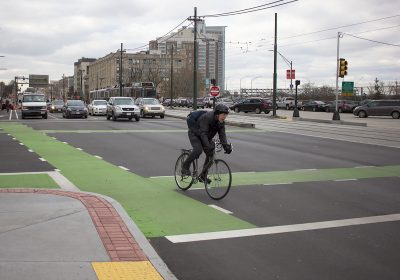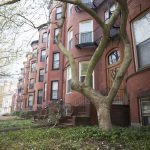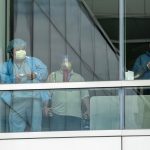Bike lanes that popped up in Downtown Boston this year are going to be sticking around as the City edges closer to make Downtown jobs more accessible to residents in other neighborhoods.

Mayor Marty Walsh announced the plan in a press conference Tuesday while giving updates on the City’s COVID-19 response. He detailed the City’s fall transportation plans, including the addition of an outbound evening bus lane from Forest Hills to Roslindale Square, a bus lane in the North End and various changes to increase pedestrian safety.
Among those projects are plans to convert the temporary bike lanes marked by orange traffic cones and barrels into permanent fixtures. The pop-up lanes appeared earlier this year as part of the city’s “Healthy Streets” initiative, with several routes emerging around the Boston Common and Public Garden. Other routes included Tremont, Boylston, Charles, Beacon and Arlington Street.
The initiative contributes to the City’s “Connect Downtown” project, the mayor said, with the goal of connecting residents in various Boston neighborhoods to jobs in the Downtown area.
“We are determined to come out of this pandemic a healthier and more equitable city than we entered it,” Walsh said at Tuesday’s press conference. “Transportation has been a critical focus of our planning effort in recent years. The pandemic brought a new urgency for safe and reliable transportation, especially for our frontline workers and essential workers that have been using it the most frequently over the last five months.”
The mayor said the City will work with neighborhoods to improve safety as well as pedestrian and bike access on American Legion Highway. Walsh said the City has heard concerns from residents, including reports of drag racing on the roadway, which stretches through Roslindale and Dorchester.
Improving bikeways on American Legion Highway is a major goal of Healthy Streets’ second phase, according to the program’s website. Other improvement locations include Cummins Highway, which intersects American Legion.
Some local transportation advocates said the announcement was a positive next step in the City’s pursuit of equity, but added that much of the current work appears to be focused in Downtown rather than other neighborhoods.
Stacy Thompson, executive director of LivableStreets Alliance, said she supports short-term interventions like the pop-up lane project, but would like to see more direct intervention when it comes to connecting the Downtown area with communities on the eastern side of the city, like Mattapan and Hyde Park.
“Cummins is a good first step, of course. We’re very excited about the progress on American Legion,” Thompson said in an interview. “What about Warren Street? What about Columbia Road? These are corridors that serve a tremendous number of people walking, biking … these are corridors that deserve attention, too.”
Thompson said she would like to see more intervention to help communities of color most affected by COVID-19 meet their transportation needs.
The Boston Cyclist Union’s executive director, Becca Wolfson, said her group is excited for the permanent lanes, but calls for more work to be done in communities outside of Downtown.
Wolfson said one criticism she has is that the current lane work has been centered around Downtown, while some neighborhoods are not seeing the same degree of new development in their corridors.
Wolfson said Roxbury, Dorchester and Mattapan are some neighborhoods where her group wants to see more progress. She added that when committing to equity, it is important that those most impacted by COVID-19, especially communities of color, receive sufficient support.
“It’s important, in general, that we right the wrongs of disinvestment when it comes to transportation in those communities and also with the lens on equity and [COVID-19] impact,” Wolfson said. “It’s critically important that if the City’s creating a Downtown network in the name of job access, that you create routes from neighborhoods to that Downtown network.”
Wolfson said these projects are happening as Boston sees an uptick in the number of new riders using the Bluebikes public bike share program.
During Tuesday’s press conference, Walsh said the City’s 90-day free pass program for essential workers is still offered for BlueBikes and that the service saw a new single-day record of 14,403 riders on Sunday.
BlueBikes Ridership has been returning to 2019 levels since it hit its lowest point in April and May, according to Boston BlueBikes marketing manager Patrick Kelsey.
In an email, Kelsey wrote BlueBikes has seen a lot of biking activity near trails, with long trips by riders who begin and end at the same bike station. He said this indicates to his group that people are riding for recreation, one of the largest use cases in the Boston metro area, in addition to others.
“There’s the commuting use case for sure,” Kelsey said in an interview. “We have a pretty large corporate program, including a lot of universities.”
He said many Bluebikes stations are also located in large employment centers and Massachusetts Bay Transportation Authority stations.
Kelsey said BlueBikes is in the process of expanding the service to five new communities this year, with plans to launch bike share stations in Arlington, Chelsea, Newton, Revere and Watertown. Some stations are already active in Arlington and Watertown, according to the BlueBikes website.















I strongly urge the city to physically block the bike lanes from the rest of the road with a hard barrier (something that has already been done on several stretches of Commonwealth Avenue). Particularly at night, motorists may think that they can safely use part of the bike lane if there isn’t a cyclist there–but seeing a cyclist in low-visibility conditions is difficult for even an attentive driver. Separated lanes will minimise accident likelihood.
I agree John. Providing some form of physical barrier and protection between the bicycle path and the driving lanes is a fantastic idea. Also, some people don’t feel safe biking in a nonprotected lane as cars speed past them. Protecting the bicycle paths will make the bicycle paths both safer and more accessible to a diversity of riders.